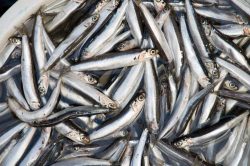
Marine life off the West Coast, from Mexico up through Canada, inhabit the California Current. The cool, nutrient-rich water supports life from invisible phytoplankton to the economically important salmon, rockfish and Dungeness crab to the majestic orcas.
A new study led by the University of Washington finds that the animals’ ability to breathe in that water may be key to where and when they thrive. The open-access study, published May 15 in Science Advances, uses recent understanding of water breathability and historical data to explain population cycles of the northern anchovy. The results for this key species could apply to other species in the current.
“If you’re worried about marine life off the west coast of North America, you’re worried about anchovies and other forage fish in the California Current. Ultimately it’s what underpins the food web,” said lead author Evan Howard, a UW postdoctoral researcher in the School of Oceanography.
The study shows that species respond to how breathable the water is — a combination of the oxygen levels in the water and the species’ oxygen needs, which are affected by water temperature. The anchovy historical data matches this pattern, and it suggests that the southern part of their range could be uninhabitable by 2100.
“This study is the first one that demonstrates on a timescale of decades that a species is responding in really close alignment with this metabolic index — how breathable the ocean in its habitat has become,” said senior author Curtis Deutsch, a UW associate professor of oceanography. “It adds a new, independent line of verification that species in the ocean are arranged in accordance with how breathable their habitats are.”
Read more at UW News »
